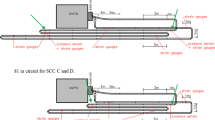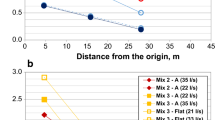Abstract
Concrete pumping technology is widely used in reservoirs, dams, harbours and other hydraulic structures. To investigate the effects of pumping on the flowability, mechanical strength and frost resistance of hydraulic concrete, long-distance pumping tests were carried out on self-compacting concrete (SCC). This paper investigated the influence of high-pressure pumping on the workability, mechanical strength and frost resistance of SCC by analysing the changes in various properties of SCC before and after long distance pumping. The flowability of the fresh concrete decreased after long-distance pumping. Compared to before pumping, the slump of the four groups of SCC decreased by an average of 3.93% and the slump-flow decreased by an average of 23.09%. The homogeneity and stability of the fresh SCC improved significantly after pumping. After pumping, the V-funnel time of SCC was reduced by an average of 82.32% and the segregation rate was reduced by an average of 125.76%. Additionally, there was a slight increase in mechanical strength indicated by an average increase of 5.87% in cubic compressive strength, 8.99% in axial compressive strength, 7.78% in tensile splitting strength, and 5.22% in modulus of elasticity. Notably, the frost resistance of the SCC showed significant improvement after pumping. Under non freeze–thaw conditions, the compressive strength of SCC after pumping increased by an average of 5.87%. After 200 freeze–thaw cycles, the compressive strength (after pumping) increased by an average of 12.46%. An air void analyser was then used to test the air-void parameters to analyse the effect of long-distance pumping action on the air voids parameters. The study further established the correlation between air-void structure characteristics and freeze–thaw resistance. Under freeze–thaw conditions, the compressive strength showed a linear correlation with air content and spacing factor. The process of pumping can enhance the air-void structure of SCC, leading to improved frost resistance. Therefore, in the design of concrete frost resistance, pumping can be considered as an influencing factor to improve the frost resistance of concrete.














Similar content being viewed by others
Data availability
The data that support the findings of this study are available from the first author, upon reasonable request.
References
Zhang Z, Wang J, Shi J, Han K, Xiao J. Understanding the effects of mix proportion parameters on the dynamic stability of ground limestone mortar based on the velocity of particle and paste film thickness. Constr Build Mater. 2022;330: 127246.
Paul SC, Tay YWD, Panda B, Tan MJ. Fresh and hardened properties of 3D printable cementitious materials for building and construction. Arch Civ Mech Eng. 2017;18(1):311–9.
Zhang Y, Cai JD, Xu SL, Hu ZJ. Experimental analysis of relationship between pore-structure and frost-resistance of concrete. Appl Mech Mater. 2012;174–177:117–20.
Ivanović B, Saha A, Stević Ž, Puška A, Zavadskas EK. Selection of truck mixer concrete pump using novel MEREC DNMARCOS model. Arch Civ Mech Eng. 2022;22(4):173–94.
Revilla-Cuesta V, Skaf M, Santamaría A, Romera JM, Ortega-López V. Elastic stiffness estimation of aggregate–ITZ system of concrete through matrix porosity and volumetric considerations: explanation and exemplification. Arch Civ Mech Eng. 2022;22(2):59–76.
Hao J, Yu B, Li Y, Mu J, Sui C, Cui Y. Effect of high pump pressure on chloride migration in ITZ of concrete. J Build Eng. 2023;66: 105926.
Kim JS, Kwon SH, Jang KP, Choi MS. Concrete pumping prediction considering different measurement of the rheological properties. Constr Build Mater. 2018;171:493–503.
Wallevik JE, Wallevik OH. Concrete mixing truck as a rheometer. Cem Concr Res. 2020;127: 105930.
Vosahlik J, Riding KA, Feys D, Lindquist W, Keller L, Van Zetten S, et al. Concrete pumping and its effect on the air void system. Mater Struct. 2018;51(4):94–108.
Li F, Shen W, Yuan Q, Hu X, Li Z, Shi C. An overview on the effect of pumping on concrete properties. Cement Concr Compos. 2022;129: 104501.
Secrieru E, Mohamed W, Fataei S, Mechtcherine V. Assessment and prediction of concrete flow and pumping pressure in pipeline. Cement Concr Compos. 2020;107: 103495.
Secrieru E, Mechtcherine V, Schroefl C, Bonin D. Rheological characterisation and prediction of pumpability of strain-hardening cement-based-composites (SHCC) with and without addition of superabsorbent polymers (SAP) at various temperatures. Construction & Building Materials. 2016; 112(jun.1): 581–594.
Jang KP, Choi MS. How affect the pipe length of pumping circuit on concrete pumping. Constr Build Mater. 2019;208:758–66.
Feys D, Schutter GD, Fataei S, Martys NS, Mechtcherine V. Pumping of concrete: Understanding a common placement method with lots of challenges. Cem Concr Res. 2022;154: 106720.
Feys D, De Schutter G, Khayat KH, Verhoeven R. Changes in rheology of self-consolidating concrete induced by pumping. Mater Struct. 2016;49(11):4657–77.
Ke G, Wang J, Tian B. Simulation analysis of pumping and its variability for manufactured sand concrete. ACI Mater J. 2019;116(3):35–42.
Ma L, Zhang Q, Lombois-Burger H, Jia Z, Zhang Z, Niu G, et al. Pore structure, internal relative humidity, and fiber orientation of 3D printed concrete with polypropylene fiber and their relation with shrinkage. J Build Eng. 2022;61: 105250.
Ahmed HU, Mohammed AA, Mohammed AS. Effectiveness of nano-SiO2 on the mechanical, durability, and microstructural behavior of geopolymer concrete at different curing ages. Arch Civ Mech Eng. 2023;23(2):129–57.
Barluenga G, Giménez M, Sepulcre A, Palomar I. Effect of full scale pumping at early age and on hardened microstructure and properties of SCC with fly ash in hot-dry curing conditions. Constr Build Mater. 2018;191:1128–38.
Yuan J, Wu Y, Zhang J. Characterization of air voids and frost resistance of concrete based on industrial computerized tomographical technology. Constr Build Mater. 2018;168:975–83.
Xu Y, Ye H, Yuan Q, Shi C, Gao Y, Fu Q. The durability of concrete subject to mechanical load coupled with freeze–thaw cycles: a review. Arch Civ Mech Eng. 2022;22(1):47–65.
Demir İ, Filazi A, Sevim O, Simsek O. Influence of freeze–thaw cycling on properties of cementitious systems doped with fly ash having optimized particle size distribution. Arch Civ Mech Eng. 2022;22(4):189–211.
GB50080–2016, Standard for test method of performance on ordinary fresh concrete , China Architecture & Building Press, Beijing, 2016.
GB50081–2019, Standard for test methods of concrete physical and mechanical properties, China Architecture & Building Press, Beijing, 2019.
GB/T50082–2009, Standard for test methods of long-term performance and durability of ordinary concrete, China Architecture & Building Press, Beijing, 2009.
DL/T 5150–2017, Test code for hydraulic concrete , National Energy Administration, Beijing, 2017.
Zeng X, Lan X, Zhu H, Long G, Xie Y. Investigation on air-voids structure and compressive strength of concrete at low atmospheric pressure. Cement Concr Compos. 2021;122: 104139.
Lan X, Zhu H, Zeng X, Long G, Xie Y. How nano-bubble water and nano-silica affect the air-voids characteristics and freeze-thaw resistance of air-entrained cementitious materials at low atmospheric pressure? J Build Eng. 2023;69: 106179.
Wang Y, Zhang S, Niu D, Fu Q. Quantitative evaluation of the characteristics of air voids and their relationship with the permeability and salt freeze–thaw resistance of hybrid steel-polypropylene fiber–reinforced concrete composites. Cement Concr Compos. 2022;125: 104292.
Choi MS, Kim YJ, Jang KP, Kwon SH. Effect of the coarse aggregate size on pipe flow of pumped concrete. Constr Build Mater. 2014;66:723–30.
Li Y, Hao J, Wang Z, Guan Z, Liu J, Jin C. Influence of ultra-high-rise pumping on microstructure and multi-scale mechanical properties of concrete based on X-ray CT and 3D mesoscopic numerical simulation. Constr Build Mater. 2021;267: 120980.
Yu L. Influence of viscosity enhancing agent on bubble parameters and freezing resistance of conrete: Harbin Institute of Technology; 2018.
Feys D, Roussel N, Verhoeven R, Schutter GD, editors. Influence of air bubbles size and volume fraction on rheological properties of fresh self-compacting concrete. International RILEM symposium on rheology of cement suspensions such as fresh concrete, 2009.
Cheng X, Tian W, Gao J, Guo J, Wang X. Grey entropy analysis of strength and void structure of carbon nanotubes concrete under the coupling of sulfate attack and freeze-thaw cycles. Constr Build Mater. 2022;358: 129462.
Lu J, Pei W, Zhang M, Wan X, Zhang J, Wang Y. Coupled effect of the freeze-thaw cycles and salt erosion on the performance of concretes modified with nanoparticles. Cold Reg Sci Technol. 2024;217: 104046.
Xiao J, Lv Z, Duan Z, Zhang C. Pore structure characteristics, modulation and its effect on concrete properties: a review. Constr Build Mater. 2022;358: 129462.
Jin S, Zhang J, Huang B. Fractal analysis of effect of air void on freeze–thaw resistance of concrete. Construction & Building Materials. 2013; 47(oct.): 126–130.
Wang J, Niu D, He H. Frost durability and stress–strain relationship of lining shotcrete in cold environment. Constr Build Mater. 2019;198:58–69.
Zhang J, Gao X, Yu L. Improvement of viscosity-modifying agents on air-void system of vibrated concrete. Constr Build Mater. 2020;239: 117843.
Funding
The authors would like to acknowledge the financial support by the Natural Science Foundation of Inner Mongolia Autonomous Region (2022QN05034, 2023MS5044); National Natural Science Foundation of China (51868055, 52368034); the National Key R&D Program of China-Key materials and preparation technology of high crack resistant ready-mixed concrete (2017YFB0310100).
Author information
Authors and Affiliations
Corresponding author
Additional information
Publisher's Note
Springer Nature remains neutral with regard to jurisdictional claims in published maps and institutional affiliations.
Rights and permissions
Springer Nature or its licensor (e.g. a society or other partner) holds exclusive rights to this article under a publishing agreement with the author(s) or other rightsholder(s); author self-archiving of the accepted manuscript version of this article is solely governed by the terms of such publishing agreement and applicable law.
About this article
Cite this article
Hao, J., Meng, Y., Cui, Y. et al. The influence of long-distance pumping on the workability, mechanical strength, and frost resistance of SCC. Archiv.Civ.Mech.Eng 24, 91 (2024). https://doi.org/10.1007/s43452-024-00884-y
Received:
Revised:
Accepted:
Published:
DOI: https://doi.org/10.1007/s43452-024-00884-y




